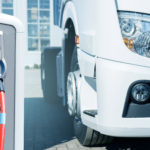EV Basics – Maximising EV efficiency
Just like with other types of vehicles, you can maximise the lifespan and operability of your EV, depending on how it is used and maintained.
What can affect EV efficiency?
The range is usually determined by the capacity of a fully charged battery and the power of the vehicle’s electric powertrain, but there are also other factors that can affect the range performance.
Source: American Automotive Association [1]
To maximise the driving efficiency of an EV, one can follow these five suggestions: [2]
- Conserve momentum: Just like with conventional vehicles, conserving momentum is the best method for efficient driving as it reduces the additional need for accelerating and braking, and thus energy consumption.
- Avoid harsh braking: One of the key features of EVs is regenerative braking, where some of the movement (kinetic energy) is converted back into electricity to recharge the batteries. Once a driver stops accelerating the motor creates a reverse torque – slowing down the car. Energy captured through regenerative braking is ~10% in normal driving and up 30% on descents. Regenerative braking differs from vehicle to vehicle.
- Observe the speed limit: EVs tend to be more efficient at lower speeds – which is why they are great for city driving.[3]
- Reconsider use of heating and air conditioning: the use of heating or air cooling in an EV has the most impact on energy efficiency when in extreme conditions.
- Be aware of eco-features: Most EVs have eco-driving features that can increase the driving range up to 20%.
Note: Checking that tyres are correctly inflated, closing windows at higher speeds and removing unnecessary weight from the car can also improve driving efficiency- just like in internal combustion engine vehicles.
Maximising range in extreme weather conditions
Extreme weather conditions can have an impact on battery efficiency. However, understanding the effects of the weather, and the tips to counteract them, will allow for range optimisation.
The biggest drain on an electric vehicle battery is the use of the air-conditioning and heating systems.
In freezing conditions (-6°C), when the vehicles’ heating is being used, range can be reduced by around 40%. Similarly, driving in hot conditions (35°C +) with the use of air conditioning, range can be reduced by approximately 17%. [1] For this purpose, one can maximise driving range when driving in extreme weather conditions by: [4]
- Using the precondition mode: Most EVs have a precondition mode that allows you to heat or cool the cabin (and battery) remotely. This can be activated when the EV is still connected so it uses electricity directly from the grid (or the power source) instead of using the electricity stored in the battery.
- Using seat heaters: Most EVs use resistance heaters to heat the air in the cabin, which consumes a lot of power. Preheating the car while plugged in, and then switching to a seat heater, will extend the efficiency of your vehicle in cold weather. [5]
- Parking the car in a garage: This will protect the battery from extreme cold, particularly if there is insulation in the garage or parking facilities.
- Parking in the shade: When parking for long periods of time, it is wise to park in the shade to stop the vehicle and battery from getting warm in direct sun.
Maximising the life of an electric vehicle battery
It is important to charge your battery correctly, to maximise its life span. Vehicle manufacturers, such as Nissan, believe that EV batteries will outlast the vehicles they are in by 10-12 years.[6]
To maximise the lifespan of a battery:
- Avoid charging to full when possible. Just like with other batteries, EV batteries degrade faster when they are frequently fully charged or completely drained. To maximise the battery’s life, keep it charged between 20% and 80% of the onscreen capacity. Many EV drivers only charge every few days to meet their driving requirements. [7]
- Use timers when charging. Allow the battery to have a cooling period in between charging and driving to minimise the use of the battery when the cells voltage is high. For this a simple clock timer used as a reminder to unplug your EV 30-60 minutes before the drive can be helpful. [8]
Source: American Automotive Association [9]
Understand what powers an EV.
References
- https://www.aaa.com/AAA/common/AAR/files/AAA-Electric-Vehicle-Range-Testing-Report.pdf
- https://www.energysavingtrust.org.uk/sites/default/files/reports/Efficient%20driving%20in%20electric%20and%20low%20emission%20vehicles.pdf
- https://www.energy.gov/eere/electricvehicles/maximizing-electric-cars-range-extreme-temperatures
- https://www.greencarreports.com/news/1081982_electric-cars-in-winter-six-steps-to-maximize-driving-range
- https://www.greencarreports.com/news/1081982_electric-cars-in-winter-six-steps-to-maximize-driving-range
- https://www.autonews.com/automakers-suppliers/nissan-looks-ways-use-long-lasting-ev-batteries
- https://www.fleetnews.co.uk/electric-fleet/charging-and-infrastructure/make-your-electric-vehicle-battery-last-longer
- https://www.plugincars.com/eight-tips-extend-battery-life-your-electric-car-107938.html
- https://exchange.aaa.com/automotive/automotive-testing/electric-vehicle-range/

 EV Basics – EV Driving Range
EV Basics – EV Driving Range EV Basics – EV Batteries
EV Basics – EV Batteries EV Fleet for Bus Operators
EV Fleet for Bus Operators An introduction to electric road freight vehicles
An introduction to electric road freight vehicles